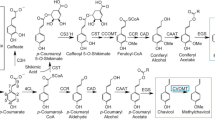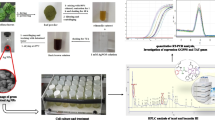Abstract
Engineered nanoparticles can alter the metabolism pathways and the profiling of metabolites in plants. In this study, we prepared the β-cyclodextrin nanoparticles (β-CDNPs) and characterized the physical and chemical structure of nanoparticles by the transmission electron microscopy (TEM) and dynamic light scattering (DLS), and zeta potential. Then, we provided the different concentrations of β‑CDNPs, including 0, 10, 50, 100 mg/L to treat the aerial parts of basil) Ocimum basilicum c.v. Keshkeni luvelou (and evaluated the profiling of essential oils by GC-MS analysis responding to β-CDNPs. The concentration of volatile compounds in the aerial parts of basil was significantly different when exposed to β‑CDNPs compared to the control. Our findings indicated that the concentration of 50 ppm β-CDNPS led to a significant increase of monoterpenes (13.77%) and sesquiterpenes (0.67%) when compared to the control. Furthermore, we investigated the expression of four key genes involved in the biosynthesis pathway of terpenoids under the different concentrations of β-CDNPs. Compared to control, the expression of linalool synthase, geraniol synthase, myrcene synthase, and cadinene synthase significantly increased in 50 ppm β-CDNPs, although the expression pattern of genes changed in a concentration-dependent manner. The nanoparticles accumulate biologically active compounds which increase plant resistance. Inducer elicitor type and effective concentration, in addition to genomics, affected the essence of Ocimum basilicum grown in this study and has caused in some concentrations more essence is produced with the expression of relevant gene in addition to increasing essence amount due to confinement in β-cyclodextrin nanoparticles. Therefore, β-CDNPS can be applied as an elicitor to induce essential oils in basil and increase the content of volatiles compounds for food and drug consumption.



Similar content being viewed by others
REFERENCES
Pisoschi, A.M., Pop, A., Cimpeanu, C., Turcucs, V., Predoi, G., and Iordache, F., Nanoencapsulation techniques for compounds and products with antioxidant and antimicrobial activity—A critical view, Eur. J. Med. Chem., 2018, vol. 157, p. 1326. https://doi.org/10.1016/j.ejmech.2018.08.076
Rastogi, S., Meena, S., Bhattacharya, A., Ghosh, S., Shukla, R.K., Sangwan, N.S., Lal, R.K., Gupta, M.M., Lavania, U.C., and Gupta, V., De novo sequencing and comparative analysis of holy and sweet basil transcriptomes, BMC Genomics, 2014, vol. 15, p. 588. https://doi.org/10.1186/1471-2164-15-588
Lewinsohn, E., Ziv-Raz, I., Dudai, N., Tadmor, Y., Lastochkin, E., Larkov, O., Chaimovitsh, D., Ravid, U., Putievsky, E., and Pichersky, E., Biosynthesis of estragole and methyl-eugenol in sweet basil (Ocimum basilicum L.). Developmental and chemotypic association of allylphenol O-methyltransferase activities, Plant Sci., 2000, vol. 160, p. 27. https://doi.org/10.1016/S0168-9452(00)00357-5
Dubey, V.S., Bhalla, R., and Luthra, R., An overview of the non-mevalonate pathway for terpenoid biosynthesis in plants, J. Biosci., 2003, vol. 28, p. 637. https://doi.org/10.1007/BF02703339
Annamalai, S., Santhanam, M., Selvaraj, S., Sundaram, M., Pandian, K., and Pazos, M., “Green technology”: bio-stimulation by an electric field for textile reactive dye contaminated agricultural soil, Sci. Total Environ., 2018, vol. 624, p. 1649. https://doi.org/10.1016/j.scitotenv.2017.10.047
Zhou, P., Yang, J., Zhu, J., He, S., Zhang, W., Yu, R., Zi, J., Song, L., and Huang, X., Effects of β-cyclodextrin and methyl jasmonate on the production of vindoline, catharanthine, and ajmalicine in Catharanthus roseus cambial meristematic cell cultures, Appl. Microbiol. Biotechnol., 2015, vol. 99, p. 7035. https://doi.org/10.1007/s00253-015-6651-9
Wang, J., Cao, Y., Sun, B., and Wang, C., Physicochemical and release characterization of garlic oil-β-cyclodextrin inclusion complexes, Food Chem., 2011, vol. 127, p. 1680. https://doi.org/10.1016/j.foodchem.2011.02.036
van Uden, W., Woerdenbag, H.J., and Pras, N., Cyclodextrins as a useful tool for bioconversions in plant cell biotechnology, in Primary and Secondary Metabolism of Plants and Cell Cultures III, Schripsema, J. and Verpoorte, R., Eds., Dordrecht: Springer-Verlag, 1994, p. 103. https://doi.org/10.1007/978-94-011-0237-7_3
Li, Z., Li, H., Wang, C., Xu, J., Singh, V., Chen, D., and Zhang, J., Sodium dodecyl sulfate/β-cyclodextrin vesicles embedded in chitosan gel for insulin delivery with pH-selective release. Acta Pharm. Sin., B, 2016, vol. 6, p. 344. https://doi.org/10.1016/j.apsb.2016.03.003
Pfaffl, M.W., A new mathematical model for relative quantification in real-time RT-PCR, Nucleic Acids Res., 2001, vol. 29, p. e45asa. https://doi.org/10.1093/nar/29.9.e45
Wang, P., Lombi, E., Zhao, F.-J., and Kopittke, P.M., Nanotechnology: a new opportunity in plant sciences, Trends Plant Sci., 2016, vol. 21, p. 699. https://doi.org/10.1016/j.tplants.2016.04.005
Namdeo, A.G., Plant cell elicitation for production of secondary metabolites: a review, Pharmacogn. Rev., 2007, vol. 1, p. 69.
Tran, Q.H. and Le, A.-T., Silver nanoparticles: synthesis, properties, toxicology, applications and perspectives, Adv. Nat. Sci.: Nanosci. Nanotechnol., 2013, vol. 4, p. 33001. https://doi.org/10.1088/2043-6262/4/3/033001
Malik, N.A.A., Kumar, I.S., and Nadarajah, K., Elicitor and receptor molecules: orchestrators of plant defense and immunity, Int. J. Mol. Sci., 2020, vol. 21, p. 963. https://doi.org/10.3390/ijms21030963
Kfoury, M., Auezova, L., Greige-Gerges, H., and Fourmentin, S., Cyclodextrins for essential oils applications, in Cyclodextrin Applications in Medicine, Food, Environment and Liquid Crystals. Environmental Chemistry for a Sustainable World, Environ. Chem. Sustainable World Ser., vol. 17, Fourmentin, S., Crini, G., and Lichtfouse, E., Eds., Cham: Springer-Verlag, 2018, p. 81, https://doi.org/10.1007/978-3-319-76162-6_4
Bilia, A.R., Guccione, C., Isacchi, B., Righeschi, C., Firenzuoli, F., and Bergonzi, M.C., Essential oils loaded in nanosystems: a developing strategy for a successful therapeutic approach, J. Evidence-Based Complementary Altern. Med., 2014, vol. 2014, art. ID 651593. https://doi.org/10.1155/2014/651593
Ciobanu, A., Landy, D., and Fourmentin, S., Complexation efficiency of cyclodextrins for volatile flavor compounds, Food Res. Int, 2013, vol. 53, p. 110. https://doi.org/10.1016/j.foodres.2013.03.048
Kfoury, M., Borgie, M., Verdin, A., Ledoux, F., Courcot, D., Auezova, L., and Fourmentin, S., Essential oil components decrease pulmonary and hepatic cells inflammation induced by air pollution particulate matter, Environ. Chem. Lett., 2016, vol. 14, p. 345. https://doi.org/10.1007/s10311-016-0572-4
Sarigiannis, D.A., Karakitsios, S.P., Gotti, A., Liakos, I.L., and Katsoyiannis, A., Exposure to major volatile organic compounds and carbonyls in European indoor environments and associated health risk, Environ. Int., 2011, vol. 37, p. 743. https://doi.org/10.1016/j.envint.2011.01.005
Misawa, M. and Takahashi, J., Generation of reactive oxygen species induced by gold nanoparticles under x‑ray and UV irradiations, Nanomed.: Nanotechnol., Biol. Med., 2011, vol. 7, p. 604. https://doi.org/10.1016/j.nano.2011.01.014
Polo, S.E. and Jackson, S.P., Dynamics of DNA damage response proteins at DNA breaks: a focus on protein modifications, Genes Dev., 2011, vol. 25, p. 409. https://doi.org/10.1101/gad.2021311
Lijavetzky, D., Almagro, L., Belchi-Navarro, S., Martínez-Zapater, J.M., Bru, R., and Pedreño, M.A., Synergistic effect of methyljasmonate and cyclodextrin on stilbene biosynthesis pathway gene expression and resveratrol production in Monastrell grapevine cell cultures, BMC Res. Notes, 2008, vol. 1, p. 132. https://doi.org/10.1186/1756-0500-1-132
Yang, T., Fang, L., Nopo-Olazabal, C., Condori, J., Nopo-Olazabal, L., Balmaceda, C., and Medina-Bolivar, F., Enhanced production of resveratrol, piceatannol, arachidin-1, and arachidin-3 in hairy root cultures of peanut co-treated with methyl jasmonate and cyclodextrin, J. Agric. Food Chem., 2015, vol. 63, p. 3942. https://doi.org/10.1021/jf5050266
Kfoury, M., Auezova, L., Ruellan, S., Greige-Gerges, H., and Fourmentin, S., Complexation of estragole as pure compound and as main component of basil and tarragon essential oils with cyclodextrins, Carbohydr. Polym., 2015, vol. 118, p. 156. https://doi.org/10.1016/j.carbpol.2014.10.073
Mourtzinos, I., Kalogeropoulos, N., Papadakis, S.E., Konstantinou, K., and Karathanos, V.T., Encapsulation of nutraceutical monoterpenes in β-cyclodextrin and modified starch, J. Food Sci., 2008, vol. 73, p. S89. https://doi.org/10.1111/j.1750-3841.2007.00609.x
Paramera, E.I., Konteles, S.J., and Karathanos, V.T., Stability and release properties of curcumin encapsulated in Saccharomyces cerevisiae, β-cyclodextrin and modified starch, Food Chem., 2011, vol. 125, p. 913. https://doi.org/10.1016/j.foodchem.2010.09.071
Santana, A.A., Kurozawa, L.E., de Oliveira, R.A., and Park, K.J., Influence of process conditions on the physicochemical properties of pequi powder produced by spray drying, Drying Technol., 2013, vol. 31, p. 825. https://doi.org/10.1080/07373937.2013.766619
Tao, F., Hill, L.E., Peng, Y., and Gomes, C.L., Synthesis and characterization of β-cyclodextrin inclusion complexes of thymol and thyme oil for antimicrobial delivery applications, LWT–Food Sci. Technol., 2014, vol. 59, p. 247. https://doi.org/10.1016/j.lwt.2014.05.037
Lücker, J., Bouwmeester, H.J., Schwab, W., Blaas, J., van der Plas, L.H.W., and Verhoeven, H.A., Expression of Clarkia S-linalool synthase in transgenic petunia plants results in the accumulation of S-linalyl-β-d-glucopyranoside, Plant J., 2001, vol. 27, p. 315. https://doi.org/10.1046/j.1365-313x.2001.01097.x
Zamboni, A., Gatto, P., Cestaro, A., Pilati, S., Viola, R., Mattivi, F., Moser, C., and Velasco, R., Grapevine cell early activation of specific responses to DIMEB, a resveratrol elicitor, BMC Genomics, 2009, vol. 10, p. 363. https://doi.org/10.1186/1471-2164-10-363
ACKNOWLEDGMENTS
The authors are grateful to the Razi Herbal Medicine Research Center of Lorestan University of Medical Sciences for their contribution in implementing the project.
Author information
Authors and Affiliations
Contributions
Azadeh Loni: data curation, writing—original draft, conceptualization, methodology, resources, formal analysis. Sara Saadatmand: review and editing, supervision, project administration. Hossien Lari Yazdi: validation, supervision, project administration. alireza iranbakhsh: software, supervision, project administration.
Corresponding author
Ethics declarations
Conflict of interests. The authors declare that they have no conflicts of interest.
Statement on the welfare of humans or animals. This article does not contain any studies involving animals performed by any of the authors.
Additional information
Abbreviations: β-CDNPS—β-cyclodextrin nanoparticles; DLS—dynamic light scattering; GC-MS—gas chromatography-mass spectrometer; TEM—transmission electron microscopy.
Supplementary Information
Rights and permissions
About this article
Cite this article
Loni, A., Saadatmand, S., Yazdi, H.L. et al. Effect of β-Cyclodextrin Nanoparticle on Biosynthesis of Ocimum basilicum L. Monoterpenes, Sesquiterpenes in a Concentration-Dependent Behavior. Russ J Plant Physiol 68, 1087–1097 (2021). https://doi.org/10.1134/S102144372106011X
Received:
Revised:
Accepted:
Published:
Issue Date:
DOI: https://doi.org/10.1134/S102144372106011X




